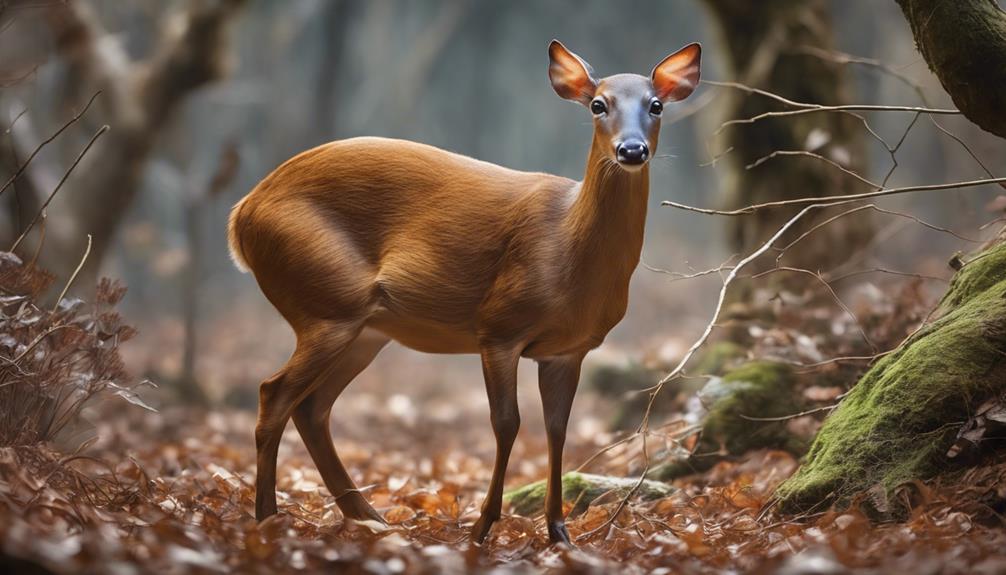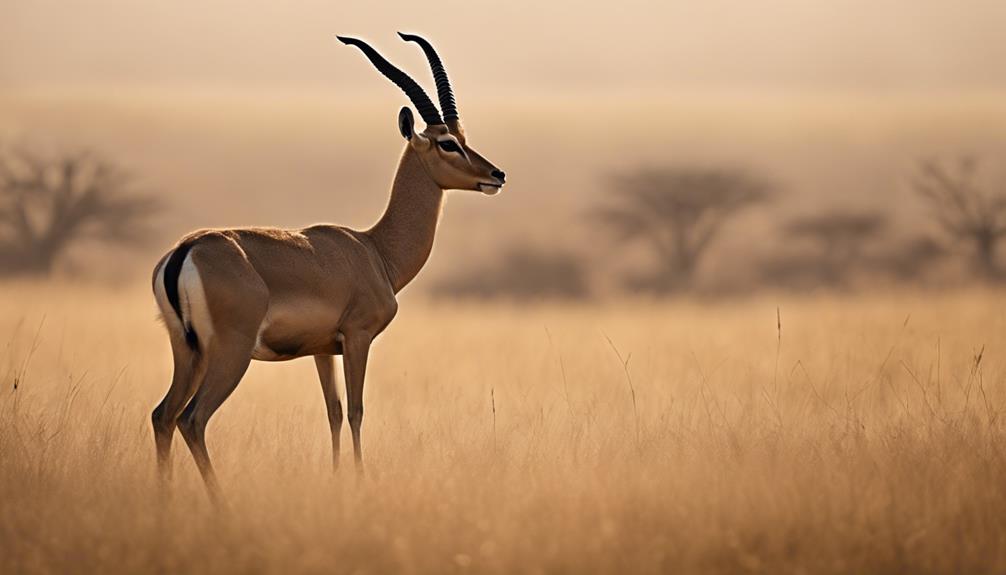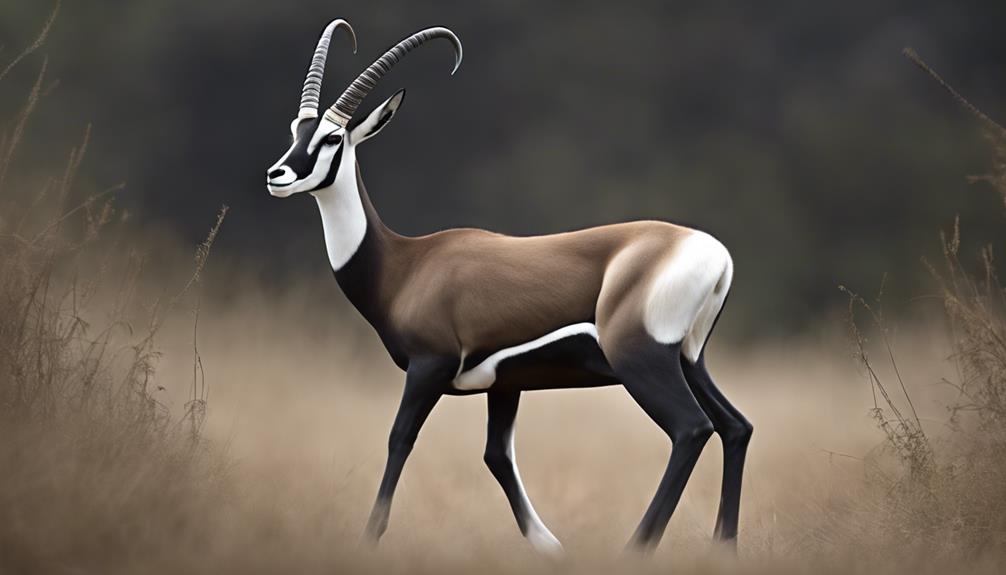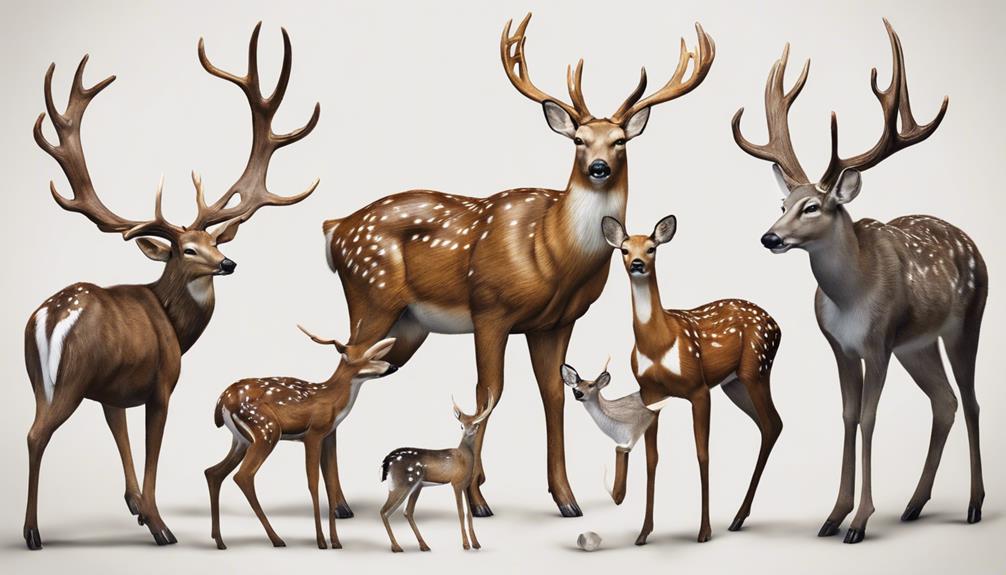When searching for animals such as deer, you may want to explore reindeer with their iconic antlers, water deer from China, and vocal muntjacs that prefer dense forests. Chinkara, a desert species found in Iran and India, along with blackbuck from India and Nepal, known for their striking black and white coats, are also unique options. Gemsbok, adapted to harsh arid regions, can be found in the Kalahari Desert. Their interesting characteristics and habitats make them worthy of further exploration.
Key Takeaways
- Reindeer: Iconic antlers, thick fur, and varied diet set them apart.
- Water Deer: Prominent tusks, semi-aquatic lifestyle, and endangered status.
- Muntjac: Known for barking vocalizations, dense forest habitat, and tusk-like canine teeth.
- Chinkara: Desert-dwelling with brown fur, short horns, and water-independent survival.
- Blackbuck: Native to India, striking black and white coat, and distinctive spiral horns.
Reindeer
Reindeer stand out among animals resembling deer due to their iconic antlers present in both males and females. These antlers can reach impressive lengths of up to 51 inches tall, making them a striking feature of the reindeer's appearance.
Not only do reindeer possess long legs that help them navigate through various terrains, but they also exhibit a relatively small size compared to other deer species. Despite their smaller stature, reindeer are well-adapted to cold climates, with thick fur coats that provide insulation against the harsh Arctic weather.
In addition to their physical attributes, reindeer are known for their agility and speed, allowing them to swiftly traverse snowy landscapes. Their ability to swim with ease also sets them apart from other deer, often inhabiting regions with forests and wetlands.
With a varied diet consisting of mosses, lichens, and grasses, reindeer showcase remarkable versatility in their feeding habits. It's no wonder they hold a significant place in folklore and mythology across different cultures, adding to their mystique and allure.
Water Deer

Water deer are a unique species due to their lack of antlers and prominent tusks that set them apart from other deer.
Originating from China and Korea, these deer are known for their semi-aquatic lifestyle, feeding primarily on aquatic plants to adapt to their habitat.
Despite their name, water deer showcase behaviors that differ from traditional deer species, making them a fascinating subject of study in the animal kingdom.
Unique Antler-less Deer
Native to marshlands and riversides in China and Korea, the unique antler-less deer known as Water Deer sport prominent tusks in place of traditional antlers. These tusks, which can grow up to 2 inches long, are used for defense and territorial disputes. Unlike other deer species, Water Deer would never grow antlers, making them easily distinguishable.
Living a semi-aquatic lifestyle, they feed on aquatic plants near water bodies. Due to habitat loss and hunting, these deer are endangered in their native range. Also called Korean Water Deer or Vampire Deer, they showcase a remarkable adaptation with their tusks, showcasing nature's diversity in deer species.
Aquatic Adaptation of Deer
Adapting to their aquatic surroundings in China and Korea, the water deer's unique feature of tusks in place of antlers sets them apart from other deer species. These adaptations help them thrive in their marshland and riverbank habitats by allowing them to access food sources both on land and in the water.
Here are some interesting facts about water deer:
- Water deer, also known as vampire deer, lack antlers and have long, sharp tusks instead.
- They've a semi-aquatic lifestyle, often seen feeding on aquatic plants and grasses near water bodies.
- Native to China and Korea, water deer face threats from habitat loss and hunting, leading to their endangered status.
- The distinctive appearance and behavior of water deer make them a fascinating example of deer adaptation to aquatic environments.
Habitat and Behavior
In their marshland and riverside habitats, the distinctive water deer exhibit behavior that showcases their adaptation to a semi-aquatic lifestyle. These unique creatures, primarily found in China and Korea, have evolved to thrive in semi-aquatic environments like marshes and riverbanks. Their diet includes a variety of aquatic plants and grasses, perfectly suited to their habitat.
Due to habitat loss and hunting, water deer are now considered endangered in the wild. Their behavior involves feeding near water sources and displaying a semi-aquatic lifestyle that sets them apart from other deer species. By observing their habits in these habitats, we can appreciate the remarkable adaptation of water deer to their surroundings, highlighting the importance of preserving their unique ecosystems.
Muntjac

Muntjac, a small deer species, are distinguished by their distinctive barking vocalizations. These creatures, found in South Asia and Southeast Asia, prefer dense forests for their habitat. Male muntjacs stand out due to their tusk-like canine teeth, giving them a unique appearance in the deer family. Their ability to camouflage themselves in vegetation showcases their exceptional skills in staying hidden and protected. With their crucial nature, muntjacs play an important role in their ecosystems, contributing to the balance of their environments.
- Muntjac are known for their barking vocalizations, a unique trait within the deer family.
- They prefer dense forests as their habitat, where they can blend in effectively.
- Male muntjacs have tusk-like canine teeth, adding to their distinct features.
- These deer are masters of camouflage, using vegetation to stay hidden and safe from predators.
Chinkara

Having explored the unique characteristics of the Muntjac, it's fascinating to shift our focus to the Chinkara, also known as the Indian Gazelle, a desert-dwelling species with remarkable adaptations for arid environments.
Chinkara thrives in harsh desert regions, showcasing brown fur and short horns that are typical of gazelles. What sets the Chinkara apart is its ability to survive without direct access to water. This gazelle achieves this feat by consuming dew, making it uniquely suited for arid climates.
Found in countries like Iran, India, Pakistan, and Afghanistan, the Chinkara's adaptability allows it to inhabit a variety of habitats, showcasing its resilience in diverse environments. While resembling deer in appearance, the Chinkara boasts specialized adaptations that make it well-equipped for desert life.
Observing the Chinkara in its natural habitat provides valuable insights into how animals can thrive in challenging conditions, showcasing the wonders of nature's adaptations.
Blackbuck

Blackbucks, also scientifically known as Antilope cervicapra, are fascinating creatures native to India and Nepal. With their striking black and white coat pattern, blackbucks are easily distinguishable in the grassy plains near water sources where they typically reside.
Observing their graceful movements and impressive speed in the wild is truly a remarkable experience.
Blackbuck Physical Characteristics
Resembling deer with their brown fur and graceful features, blackbucks are native to India and Nepal. When observing a blackbuck, their physical characteristics stand out:
- Their sleek bodies are built for agility and speed, reminiscent of deer.
- The distinctive spiral horns of the males add to their majestic appearance.
- Blackbucks have large, expressive eyes that give them a sense of alertness.
- Their slender legs are designed for swift movements across the open grasslands.
These features contribute to the elegant beauty that blackbucks are known for, highlighting their similarities to deer while maintaining their unique charm as antelopes.
Blackbuck Habitat and Range
Nestled within the grassy plains near water sources, blackbucks thrive in their native habitats of India and Nepal. These striking antelopes prefer open grasslands close to water bodies, showcasing their adaptation to specific environmental conditions. Their distribution in these regions highlights their ecological niche and habitat requirements, emphasizing the importance of access to water for sustenance.
Blackbuck Behavior Observations
Observing blackbucks in their natural habitat reveals fascinating insights into their territorial behavior and social dynamics.
- Blackbucks are known for their territorial behavior, marking their territories with dung heaps and scent glands.
- Males use their horns to establish dominance and fight for mating rights with females.
- These diurnal animals are most active during the early morning and late afternoon.
- Blackbucks are herbivores, primarily feeding on grasses, fruits, and leaves.
Gemsbok

Occasionally, one may spot Gemsbok gracefully traversing the arid landscapes of the Kalahari Desert, resembling large deer bucks with their impressive appearance. These magnificent antelopes, belonging to the Oryx genus of gazelles, have adapted remarkably well to the harsh conditions of arid environments like the Kalahari.
One fascinating feature of Gemsbok is their distinct horns, with males typically sporting longer and more robust horns compared to females. Found mainly in southern Africa, Gemsbok can be observed roaming the savannas and desert regions, showcasing their striking appearance and unique adaptations that make them an alluring species to study in the wild.
Their ability to thrive in such challenging habitats serves as a proof to their resilience and evolutionary prowess. Studying Gemsbok provides valuable insights into how animals can adapt to extreme environments, making them an intriguing subject for researchers and wildlife enthusiasts alike.
Frequently Asked Questions
What Other Animal Looks Like Deer?
When I think about animals resembling deer, pronghorns come to mind. They're not genetically related to deer but share some physical similarities. It's fascinating to learn about these unique creatures.
Who Looks Like a Deer?
I believe the pronghorn, blackbuck, roan antelope, addax, and chinkara resemble deer with their unique features like coats, horns, and behavior. These animals, though not genetically related to deer, share striking similarities in appearance.
Which Is the Most Beautiful Deer Animal?
For me, the most beautiful deer animal is the fallow deer. Its graceful movements and enchanting coat color make it stand out. Their elegance in the wild is simply mesmerizing, making them a true marvel of nature.
What Animal Looks Like a Deer With Stripes?
I've noticed an animal that looks like a deer with stripes. It's the Greater Kudu, an antelope species with distinctive white stripes on its flanks. This unique creature boasts a sleek torso and impressive spiraling horns.
Are There Any Animals That Resemble Deer and Otters?
Yes, there are indeed animals resembling otters. The musk deer shares a similar appearance with its sleek body and small, rounded ears. Additionally, the lasiurus cinereus, also known as the hoary bat, bears a striking resemblance to otters with its furry body and dark eyes.
Conclusion
To sum up, animals like reindeer, water deer, muntjac, chinkara, blackbuck, and gemsbok all share some similarities with deer in their appearance.
These stunning examples showcase the diverse range of creatures that resemble deer in various ways, from their antlers to their graceful movements.
By learning about these animals, we can appreciate the beauty of nature and the fascinating adaptations that allow them to thrive in their environments.
Keep exploring the world around you to discover more amazing creatures that share similarities with deer.










